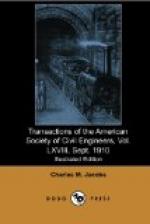Eastward from the East River tunnels, the grades were established so as to rise as uniformly as possible to the level of the Sunnyside Yard.
The general features of the line, as finally adopted and constructed, are as follows:
The maximum grade west of the Terminal Station occurs on the New York side of the North River, and is 2% in the west-bound and 1.93% in the east-bound tunnels. The ruling grades (for the ascending traffic) being 1.32% in the west-bound and 1.93% in the east-bound tunnels. In the tunnels east of the Terminal Station the ruling grade is 1.5% for both east-bound and west-bound traffic. There is, however, descending with the traffic, a short section on a grade of 1.9 per cent. These grades would be objectionable with steam locomotives under a heavy traffic, but the development of the electric locomotive has rendered possible the operation of grades which would have formerly been considered prohibitive.
From the junction with the Pennsylvania Railroad, near Harrison, N. J., to Woodside, Long Island, a distance of 13.66 miles, there is an average of 1.5 curves per mile; the line having a total curvature of 230 degrees. The maximum curvature is 2 degrees.
[Illustration: PLATE III.—P. T. & T. R. R. East River Division. Sunnyside Yard]
Method of Construction of Sub-River Tunnels.—The character of the material through which the tunnels were to be constructed differed greatly in the two rivers. The bed of the North River, at the level of the tunnels, consists of silt composed principally of clay, sand, and water, while that of the East River is formed of a great variety of materials, such as quicksand, sand, boulders, gravel, clay, and bed-rock. When the method of construction had to be decided there were no thoroughly satisfactory precedents to follow in the case of either river, although the Gas Tunnel under the East River, the partly constructed Hudson Tunnels under the North River, the St. Clair Tunnel under the St. Clair River, the Blackwall and several other tunnels under the Thames River at London, supplied much useful information. The smaller tunnels for a lighter traffic, since so successfully constructed under the North and East Rivers, had not then been completed. Under these circumstances, it was the desire of the Management that the Board should receive and consider proposed methods of construction from all available sources; and during the first year of its labors much of its time was devoted to the examination and discussion of projects submitted for its consideration by engineers and practical builders, some of these projects having decided merit. Most of the methods proposed involved temporary structures, or the use of floating plant, in the navigable channels of the river. This was objectionable in view of the resulting obstruction to the enormous river traffic. After full consideration of the subject, it was decided to adopt the shield method with compressed air for the construction of the tunnels under both rivers, this being the only method recommended by the Chief Engineers, and having the great advantage of conducting all operations below the bottom of the river, thus avoiding obstruction of the channel.




